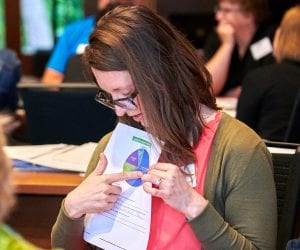In the coming decades, several countries are expected to see their population double. And many of these places are also some of the most vulnerable to climate change. As populations grow and change, it’s important for cities, nations, and the world to create climate resiliency plans that address the needs of diverse and growing populations. For example, in cities this includes planning infrastructure to withstand extreme weather, and on a global scale, we must adapt the ways in which we produce food and consume natural resources. And from a health perspective we must adapt and protect people from the spread and evolution of disease.
How does population growth factor in and relate to these issues? Read on for six connections between climate change and population growth, and links for further exploration.
Climate Migrants
Whether it’s a sudden disaster like a ravaging hurricane, or a slower change like less and less rainfall, climate change is impacting people’s livelihoods and living conditions around the world. One of the largest threats of climate change is how it can turn parts of the world from hospitable to inhospitable. These change can drive migration, as is already evident in some parts of the world. As people migrate to escape the effects of climate change, populations in many countries will shift, with millions migrating internally within their own countries. By 2050, it is expected that nearly 143 million people will be displaced within their own countries. What challenges do communities face as they adapt to influx of people fleeing climate change events? How can communities improve their response and prepare for people fleeing these situations?
Related Articles
- Hurricane Maria made me a Climate Refugee
- Climate Migrants Will Soon Shift Populations of Many Countries, Says World Bank
Poor Urban Planning
Urban planning is the development and design of land into livable urban areas such as cities – this includes infrastructure like roads and housing, as well as policies and laws that govern how a city operates. By 2030, roughly 60% of the world’s population will live in cities, and cities’ adaptation to climate change effects is an increasingly important aspect of urban planning. Whether it’s heat waves, floods, managing water resources, or disaster preparedness, cities must find solutions to not only adapt to climate change, but to ensure a growing population is taken care of. For example, consider the fact that about 29% of the U.S. population lives on or near a coastline. How can these coastal cities adapt current infrastructure and plan for new development in ways that take into consideration future hurricanes?
Related Articles
- Designing for Climate Change: How can affordable housing be more resilient to extreme weather and better prepared to deal with the consequences of climate change?
- Heat Wave: How Rising Temperatures in Urban Heat Islands are Challenging and Inspiring Developers
- Bangkok struggles to protect slum dwellers as floods worsen
Extreme Weather Events
From deadly wildfires in California, to heavy monsoons in India, climate change will cause more frequent and extreme weather events. These events can displace and harm thousands of people, as well as destroy crops, homes, and livelihoods. Since most of the world’s population growth in the next three decades will happen in countries such as Nigeria, Democratic Republic of the Congo, and India with high rates of poverty, improving climate resiliency can help already vulnerable people from plunging further into poverty. More specifically, cities are expected to absorb most of the growth in less developed countries, so it’s also crucial that urban planning consider how informal housing and slum areas will fare in the face of extreme weather. When a natural disaster or extreme weather strikes, not everyone has the resources to flee or even rebuild. How can cities, and rural areas, prepare for these events?
Related Articles
- See how a warmer world primed California for large fires
- One Climate Crisis Disaster Occurs Every Week, U.N. Official Warns
Agricultural Productivity
Global temperature increase is changing the climates of areas where food is produced. Changing weather patterns such as extreme rain fall or drought can disrupt food availability and make it more difficult to grow crops or raise animals. Especially in rural and more impoverished areas around the globe, agriculture is not only for nourishment but the main source of income for many families. Fish and seafood are also threatened by ocean acidification, which happens from greater CO2 absorption in the ocean. As population increases in many parts of the world, the demand for food will rise. And in many areas, it is already difficult to produce enough food for local communities. As climate change disrupts farmland, as more people move into cities, and as population grows in many areas, how can places find ways to increase agricultural productivity to support growing populations?
Related Article
Disease Evolution
As the overall temperature of the planet warms, more and more parts of the world are becoming the ideal environment for disease carrying insects like mosquitoes. This will shift the burden of disease around the world. For example, diseases such as malaria, West Nile virus, cholera, and Lyme disease could appear in places they’ve not previously been located. Places that did not have these diseases will have to incorporate preventative action while also providing healthcare to those who need treatment. Waterborne diseases will also become an increasing concern as we continue to see more severe weather events like hurricanes moving large amount of water and leaving stagnant pools in their paths. How can cities with a growing population prepare for treating (and preventing) diseases new to their area?
Related Articles
- Climate Change Will Expose Half of World’s Population to Disease-Spreading Mosquitoes By 2050
- Dengue Fever Ravages Asia-Pacific
Global Inequity in Climate Adaptation
Poorer countries contribute a minority of CO2 emissions, yet they will have the most difficulty adapting to climate change. For many of these countries and communities, trying to reduce poverty while simultaneously adapting to the effects of climate change is a challenge. People living in poverty are more susceptible to diseases spread by changing climates, the impacts of extreme weather events due to poor infrastructure, and the loss of their property, farmland, or livelihoods from things like floods or droughts. These losses can keep people trapped in poverty, and often force people to ultimately migrate. With growing populations in countries that are extremely vulnerable to climate change and resource scarce, this presents a challenge.
Related Articles
- The Climate Crisis is Global but these 6 places face the most severe consequences
- Expert’s take: When building climate resilience, women’s needs cannot be an afterthought
Connecting Population to Climate in Your Video
Hopefully this post has helped broaden your thinking on ways our human numbers impact climate resiliency as you consider your video entry for the World of 7 Billion student contest. As you explore these topics, think about how these issues affect your own community, city, country, or another place that interests you. What population changes are happening there? What problems do growing populations have, or might they have? How can you create a sustainable solution? We look forward to seeing your ideas and videos!




